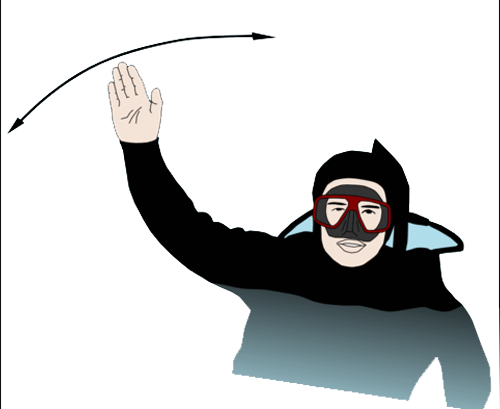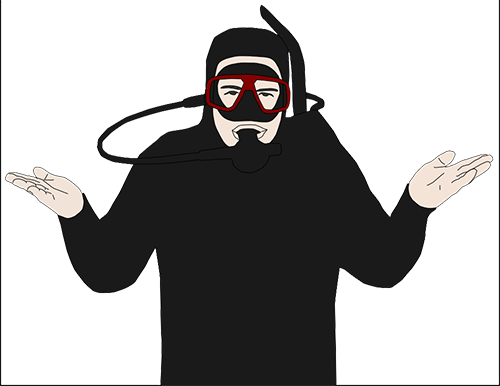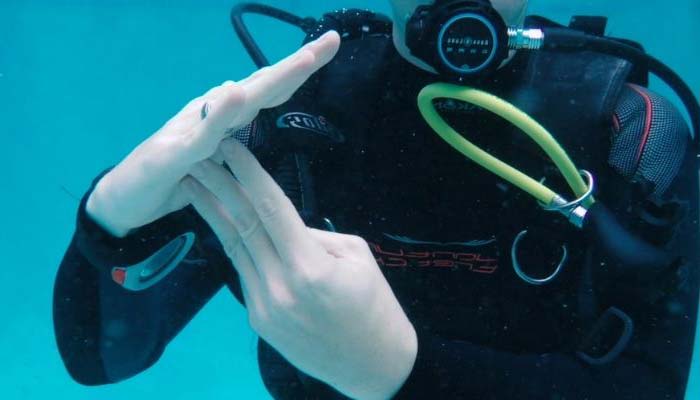Hand Signals in Diving

To fully enjoy our underwater adventure it is vital to know the hand signals in diving.
These will ensure the constant communication on which our safety underwater depends.
Whether you are a professional or recreational diver, these gestures will allow you to communicate with other divers almost anywhere in the world.
Yes, best of all, they are signs that have been recognised as universally used, endorsed by the Recreational Diving Training Council.
At Titan Blue Divers your safety and enjoyment are our top priority. So, in order for you to fully master the dive hand signals on your next adventure, we tell you in detail what they are, how and when you should do them.
Why are hand signals so important in diving?
It is quite common for anyone enthusiastic about diving to ask "Do I really need to know signals to dive?"
The answer is YES. The best part is that they are quite easy to learn and, in fact, some of them are often used in our daily lives.
Now then. Remember that, in the water, unless you are wearing masks with built-in communication systems(which are often considerably expensive and require special equipment), you will not be able to talk to your companions.
At the same time, in a sport such as diving, where communication is vital, it is essential to have a quick and clear way of reporting any situation.
In view of this reality, the diving organisations concluded that visual signals were a very good solution.
As a result, a series of gestures emerged to communicate those aspects of most relevance during a dive. For example, if we have some kind of complication, if there is any danger or to report how much air we have left.
This has proven to be highly effective and minimises the risks of not communicating in such activities. Hence the importance of using hand signals at all times when diving.

What types of Diving Signals are there?
Although hand signals are the most widely used signals in the world, they are not the only ones that exist. The reason is that in certain circumstances they are not the most convenient way to communicate.
For example, if we are on a night dive and need to signal our buddy that we have an emergency, with a traditional hand signal he will probably not even see us in the dark.
That is why there are also night dive signs for which we use a torch.
On the other hand, if we are looking to transmit more specific information underwater, it is advisable to use submersible boards. This allows us to explain in much more detail than with hand signals.
In other cases, for example, rattles or horns are often used to give acoustic signals.
Pulling on a line if you are cave diving is often another method used.
However, if you have a larger budget and are willing to make the necessary investment, you can opt for masks with microphones. These will allow you to have conversations with your partner as if you were on the surface.
Of course, the choice of one or the other technique or equipment will depend exclusively on your requirements and preferences.
What are the most commonly used hand signals in diving?
Now it's time to delve a little deeper into the subject. Now that you understand the importance of the signals in diving, we will tell you which are the most used and how to do them correctly.
To make it more practical, we have divided the different signals into 4 sections:
Trouble/Emergency; Pressure Control; Movement and Standard Information Let's get started!
PROBLEMS / EMERGENCIES

ALL OK
There are two ways to make this signal and indicate to your dive buddy that all is well. The first is to make a circle with your thumb and forefinger, while extending your remaining fingers.
In case you are wearing gloves, you can make the same signal, but without extending your fingers.

ALL RIGHT (for long distances. e.g. to a ship)
In essence, it seeks to convey the same information as in the previous case: to indicate that all is well.
However, the difference is that it is used to be visible from a long distance, so it is especially used to communicate with the skipper of a vessel.
It consists of make an "O" by placing your arms above your head. if you have both hands free.
It also works if we touch our head with one hand to make a smaller "O". This in case the other arm is occupied.

REGULAR/SOMETHING IS WRONG/I HAVE A PROBLEM
This is a gesture that is made when we want to show that there is some kind of complication. For example, if we are not able to compensate for both ears, that we are cold or that we simply don't feel well.
With with our palm outstretched and fingers spread apart, we will swing our hand back and forth on the axis of the forearm..
Generally, after making this signal, we usually indicate where the source of the problem is by pointing it out. For example, if you are having trouble compensating, you might point to your ear to tell him or her exactly what the problem is.

I'M OUT OF AIR
This signal is vitally important, as it will serve to indicate that you are in serious trouble and therefore require a partner to help you.
To do this, place your hand in front of you, with the palm facing downwards, and simulating a cut at neck or chest level.. This will signal that we need to breathe from our partner's emergency regulator or ascend to the surface.
Important: Always avoid having to reach the point where it is necessary to use this sign.

I CANNOT COMPENSATE
Lack of compensation in one ear is one of the most common problems during dives. In case of this type of problem
To do this just point to one of your ears with a finger. so that they understand that you need a few minutes to compensate.
Usually, thesignal "Something is wrong" is made first and then the source of the problem(which in this case is the difficulty to compensate) is pointed out.

EMERGENCY/RELIEF
If we have an emergency and need to be seen over long distances, it will be necessary to move your arm from side to side. This will attract the attention of your colleagues.
This is a distress call that will be visible from land or a boat and will help you to report that you had a problem during the dive and urgently require assistance.

SQUID
Dives such as drift diving often require a certain amount of physical exertion, so we would be prone to cramp.
There are certainly ways to stretch the muscle without needing help. However, the most advisable thing to do is to notify our partner so that they can help us to resolve it.
The signal in this case consists of opening and closing the fist. This should be done 2 or 3 times at a constant speed.

I'M COLD
This is another universal sign that we are likely to recognise at a glance. Before explaining it further, it is important to note that diving when cold is uncomfortable and unpleasant, so it may mean ending the dive prematurely.
Now, this will also depend on the area where you are used to diving or if you do very long dives, as you will naturally end up getting cold.
If we reach this point, it is best to suspend the dive and return to the surface.
To indicate this situation to your colleagues, simply rub your hands together with your arms repeatedly, as if you want to warm up.as if you want to warm up. Just as you would on the surface.

DANGER IN THAT DIRECTION
It is usually used when there is a dangerous situation. It consists of extend the arm towards the danger while keeping the fist clenched..
PRESSURE CONTROL

HOW MUCH AIR DO YOU HAVE LEFT?
This is another of the most common and important on every dive, as checking how much air your buddy has left could prevent him from forgetting to keep control.
At the same time it will save us from having to use the above emergency or help signals. It is absolutely essential to know how much gas you have left at all times.
The sign can be made in two ways. The first consists of touching your index and middle fingers to the palm of the other hand.
In the second one you just have to take your own pressure gauge and touch it with the front fingers. the same movement.

I HAVE "100 BARS" LEFT
When we are asked the above question ("How much air do you have left?") and we have the bottle half full (equivalent to 100 bars) we should make a signal very similar to the "Time out" signal that is often used in sports such as basketball.
In other words, we form a T-shape with both hands. This is one of the most important signals, because in recreational diving, the return or second part of the dive is usually started when the first diver has consumed half of the tank.

I HAVE "50 BARS" LEFT
This signal, together with the previous one, is one of the most important. When we make this signal we indicate that we are entering the reserve of our tank and, therefore, it implies that the ascent must begin in order to finish the dive.
To report this we must raise our clenched fist to the level of our head.. As shown in the picture.
MOVEMENT

DOWNLOAD
This is usually an indication given when a dive is about to commence, after the surface check.
It is also used when you are at a certain depth and you need to warn your colleagues that you are going to descend to a greater depth.
All you have to do is make a fist, extend the thumb of your hand and point it downwards..

ASCEND
This is a signal normally used to show that an ascent is to be made(this may be to the surface or to decrease the depth a little under any circumstances).
However, it is most often used when, after making the safety stop, the ascent to the surface is to be initiated. This gesture will serve to signal the rest of the team to ascend as well.
To do this you should make a fist and raise your thumbThe thumb should be raised by making a major emphasis that it should ascend through upward movements.
ImportantDo not confuse this signal with the "OK" signal that we normally use in our daily life. As you have seen, during a dive these signals have totally different meanings.

STOP OR HALT
It consists of the universal "Stop" or "Stop" signal and the we will do it by raising our hand. We can use it if we need to wait for colleagues, to show something for the team to see, to start climbing or for other reasons.

TURNING AROUND
When the dive guide has to signal to turn around, he will do so. making a fist with the hand, raising the index finger and rotating it in circles on its own axis..
This is usually done when the dive starts and ends at the same spot and one of the divers has used up 50% of the air in his/her tank.
STANDARD INFORMATION

"LOOK AT THAT" OR "LOOK AT".
This allows us to show our partner where to look to see something important while we are underwater.
The gesture is divided into two parts. Firstly, we point to our eyes with the index and middle finger of one hand.
Then , point in the direction where you need your partner to look..

JOIN YOUR PARTNER
This is an indication normally given by the Dive Master to inform us that we must join our buddy and not separate from him.
Remember that diving is a buddy sport, so if for any eventuality, an emergency arises, it is vital to stay together. The leader will remind you of this with this gesture in case you are getting separated.
The signal is performed by joining the index finger of each hand and pointing forward.specifically to the two partners.

SAFETY SHUTDOWN
This is a recommended stop on recreational dives, although it is normally done on all dives. In this case we stop for 3 minutes to allow the body to eliminate some of the accumulated nitrogen.
The way to indicate that a safety stop will be made is by placing the palm of one hand facing downwards with fingers spread apart.(this indicates the 5 metres at which the stop is usually made).
The signal is completed with the other hand, placing the thumb under the previously extended palm.. In this case we also show the middle and index finger(it will serve as a reference for the 3 minutes that the stop lasts).

"I DON'T KNOW"
This is another of those universal signals that are not only used during a dive, but are quite common in our daily lives. You can use it when you don't have an answer to a question your buddy or divemaster asks you.
Simply raise your shoulders and keep your palms facing upwards.
ImportantThis gesture does not apply when you are asked about your air or where your partner is. For these questions we must always have an answer.

SUBJECTS (HOLD HANDS TOGETHER)
Normally this is a signal that the Dive Master would give in case of some kind of problem such as poor visibility or strong currents.
At this time it is essential that full contact is maintained for the safety of the divers.
At the moment of making this indication we will see that the leader will bring both hands together, grasping them.. It may be an indication to only two companions(to be signalled by the dive master, if that is the case) or to the whole group.

MAINTAIN DEPTH
This is a signal that serves both to mark the decompression stop and to indicate that we are going to continue diving at that depth.
To do this, with the palm of your hand open and facing downwards, we will make movements from left to right..
ARE THESE DIVE SIGNALS STANDARDISED?
Yes, this is because diving signals are used internationally. There may be slight changes between those taught and used in different diving organisations, but for the most part they are the same.
So if you go on a trip and decide to do a dive at an unfamiliar dive centre with buddies you are not used to diving with, there is nothing to worry about. The signals you will use will be the same as the ones you are used to using with your usual group.
Similarly, it is recommended that, if, for whatever reason, they will use less common signals(or a particular one that you are not familiar with), remind them of this in the briefing..
The briefing will help you to have all the rules clear, to handle the same information as the whole team and, therefore, you will know how to make the signals you didn't know.
It will therefore be useful to ensure that, once submerged, there is no problem in this respect.

RECOMMENDATIONS FOR HAND SIGNALS IN DIVING
There are specific ways that will allow your buddy to easily perceive your signals and therefore improve communication during the dive to avoid any risks.
One of the most important recommendations is signalling at an appropriate speed.
Be aware that if you do them too quickly, your partner will probably not be able to understand what you need to tell them. This will waste their time, as they will have to ask you several times.
However, it is also not advisable to do it too slowly. It should be remembered that some signals require several movements.
Therefore, doing them too slowly could confuse our partner and make him think that we have finished before we have made all the movements necessary to transmit the complete information.
So what should be done in such cases? The ideal is to maintain a calm, but at the same time dynamic and fluid speed.. This will make communication between you and your partner effective.
They will therefore avoid awkward and in some cases even dangerous misunderstandings.
The next recommendation(especially if you use neoprene gloves on your dives) is that because most of the suits are black, it is advisable to signal with your arm away from your body..
This is, of course, where possible, as not all signals allow this.
The reason for this suggestion is that if we make them right in front of our chest, it will be more difficult for our partner to understand what we need to communicate.
On the other hand, if we move our arm away from the central area of the body, it will be much easier for him to understand whatever it is we have to tell him.
Now that you know all the hand signals in diving, start practising them now! If you have any questions(or if you want to tell us about your experience), we look forward to hearing from you in the comments.
Remember that, if you have a more specific question, Titan Blue Divers as diving instructors in Lanzarote, we will help you with any doubt.

